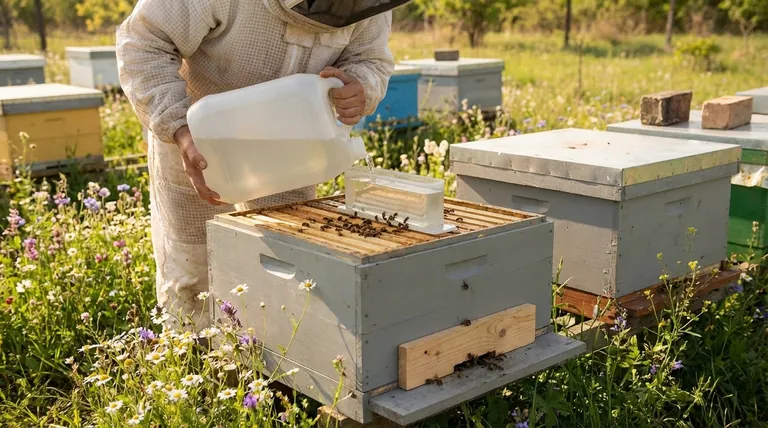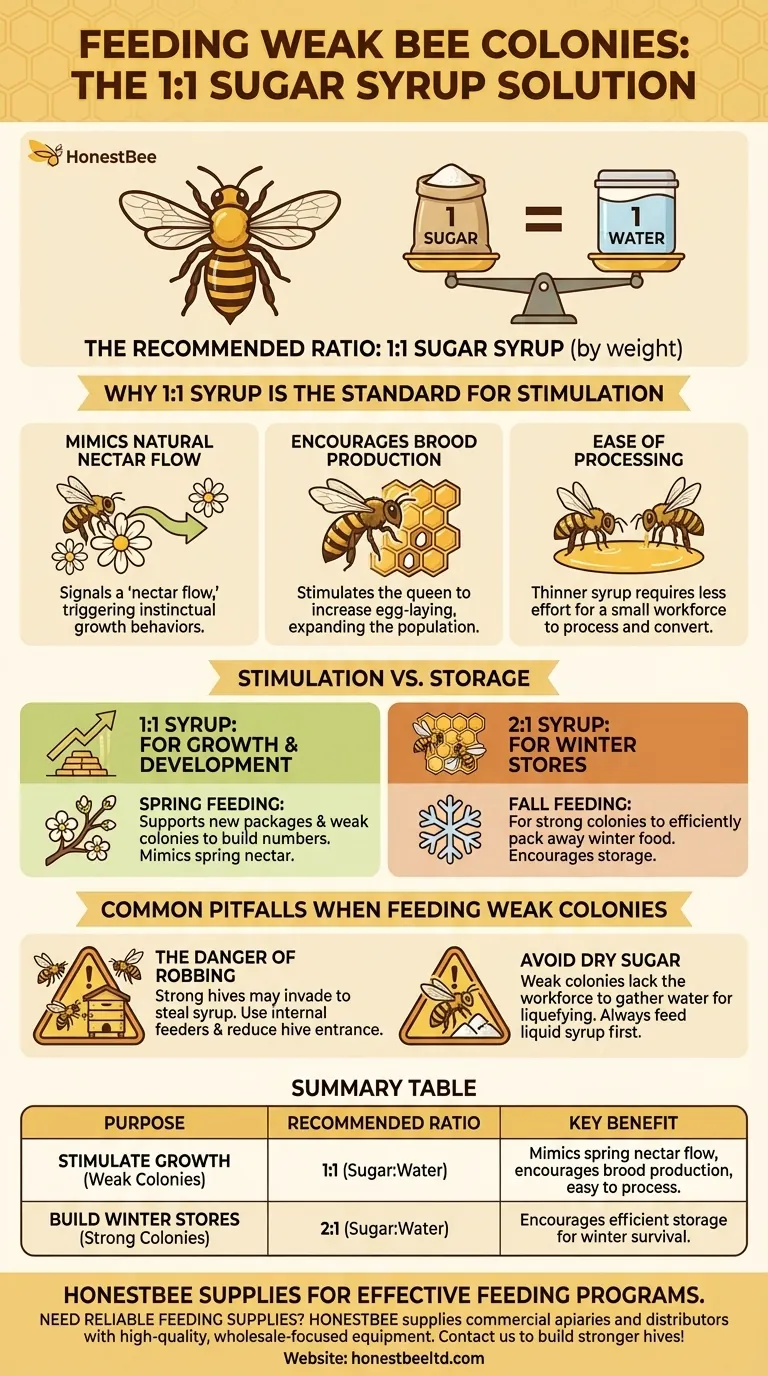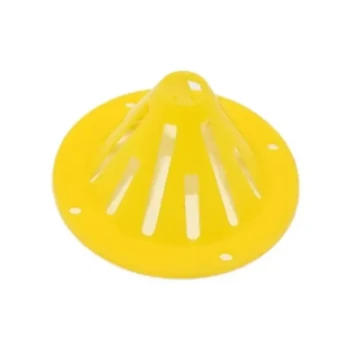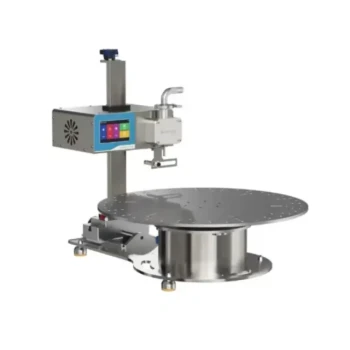For weak bee colonies, the standard and recommended feeding mixture is a 1:1 sugar syrup ratio, measured by weight. This ratio is specifically designed to act as a nectar substitute, which stimulates the queen to lay eggs and encourages the colony to expand its population—the primary needs of a weak hive.
Choosing the right sugar syrup is not just about providing food; it's about sending the correct signal to the colony. A 1:1 ratio signals a time of abundance and growth, while a thicker 2:1 ratio signals a need to store resources for winter.

Why 1:1 Syrup is the Standard for Stimulation
Feeding a weak colony is a strategic intervention. Your goal is not simply to fill their pantry but to encourage the biological processes that lead to a stronger, more populous hive.
Mimicking Natural Nectar Flow
A 1:1 sugar syrup closely mimics the consistency of natural nectar that bees gather from flowers in the spring.
This signals to the colony that a "nectar flow" has begun, triggering instinctual behaviors related to growth and expansion.
Encouraging Brood Production
The presence of this nectar-like syrup stimulates the queen to increase her rate of egg-laying. More brood (eggs, larvae, and pupae) is the most direct path to increasing the colony's population and workforce.
A weak colony's number one priority is to build its population, and 1:1 syrup is the most effective way to encourage this.
Ease of Processing
A weak colony has a smaller workforce. The thinner 1:1 syrup requires less effort for the bees to process, consume, and convert into energy or store as comb.
This easy-to-handle resource allows a small cluster of bees to get the maximum benefit with minimum energy expenditure.
The Critical Difference: Stimulation vs. Storage
Understanding the purpose behind different syrup ratios is essential for effective bee management. Using the wrong one can be counterproductive.
1:1 Syrup: For Growth and Development
This ratio (e.g., 1 pound of sugar to 1 pound of water) is used for stimulation. It is the go-to choice for spring feeding, supporting new packages, or helping a weak colony build its numbers.
2:1 Syrup: For Winter Stores
A thicker ratio (e.g., 2 pounds of sugar to 1 pound of water) is used for building winter food stores. It is primarily used in the fall with strong, healthy colonies that have the workforce to process the thick syrup and pack it into the honeycomb efficiently.
Common Pitfalls When Feeding Weak Colonies
A weak colony is vulnerable. While feeding is often necessary, it must be done with care to avoid creating new problems.
The Danger of Robbing
The smell of sugar syrup can attract bees from stronger, nearby hives. If they find the weak colony, they may invade to steal the syrup, a behavior known as "robbing."
A robbing attack will quickly destroy a weak colony. To prevent this, use internal feeders (like frame or top feeders) and consider reducing the hive entrance to a very small opening that the colony can easily defend.
Why You Must Avoid Dry Sugar
While strong colonies can sometimes be fed dry sugar, this is dangerous for a weak hive. Processing dry sugar requires the bees to collect significant amounts of water to liquefy it.
A weak colony lacks the foraging workforce to gather enough water. A starving hive should always receive liquid syrup first, as they may perish trying to process dry crystals.
Making the Right Choice for Your Goal
Your feeding strategy should always align with your specific objective for the colony.
- If your primary focus is stimulating a weak colony: Use a 1:1 sugar-to-water ratio to mimic nectar flow and encourage brood production.
- If your primary focus is building winter stores in a strong colony: Use a 2:1 sugar-to-water ratio in the fall to help them quickly pack away food.
- If your colony is at immediate risk of starvation: Use 1:1 syrup for a rapid, easily-processed source of energy, regardless of the season.
By understanding the purpose behind the feed, you can give your bees exactly what they need to thrive.
Summary Table:
| Purpose | Recommended Ratio | Key Benefit |
|---|---|---|
| Stimulate Growth (Weak Colonies) | 1:1 (Sugar:Water) | Mimics spring nectar flow, encourages brood production, easy to process. |
| Build Winter Stores (Strong Colonies) | 2:1 (Sugar:Water) | Encourages efficient storage for winter survival. |
Need reliable feeding supplies for your apiary? HONESTBEE supplies commercial apiaries and beekeeping equipment distributors with the high-quality, wholesale-focused equipment needed for effective feeding programs. Let us help you build stronger, more productive hives. Contact our team today to discuss your needs!
Visual Guide

Related Products
- Fully Automatic Honey Filling Packaging Machine for Processing Line
- Electric Honey Press Machine for Squeezing Honey Comb Press Equipment
- 10L Stainless Steel Electric Honey Press Machine
- Slatted Porter Style Bee Escape for Rapid Hive Clearing
- Double Nozzle Small Honey Filling Machine Honey Sachet Packing Packaging Equipment
People Also Ask
- What are the key features of a honey packaging machine? Essential for Quality & Efficiency
- What are the benefits of using honey filling machines? Boost Efficiency & Quality in Your Apiary
- What are the types of bottling machines used for honey? Find the Right Filler for Your Scale
- How does a heating mechanism in a honey filling machine help? Unlock Speed, Accuracy & Premium Quality
- How does automation in honey filling reduce labor costs? Boost Efficiency & Cut Costs by 30%



















